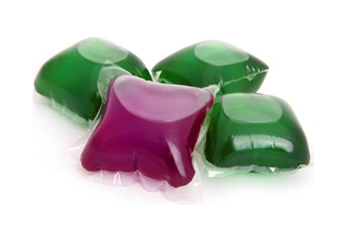CPSC and ACCC Warn of Poison Dangers with Liquid Laundry Packets

WASHINGTON, D.C. – The U.S. Consumer Product Safety Commission (CPSC) and the Australian Competition and Consumer Commission (ACCC) are urging parents to take immediate action to ensure their family is not exposed to the hazards posed by liquid laundry packets or capsules. Young children who are exposed to the highly concentrated, toxic detergent are at risk of serious injury.
Reports of incidents in the United States and Australia have prompted the product safety agencies to warn parents about what can happen if these products are not used safely. Children who have ingested detergent from the packets have required medical attention and hospitalization for loss of consciousness, excessive vomiting, drowsiness, throat swelling, and difficulty breathing. Eye contact has also resulted in reports of injury, including severe irritation and temporary loss of vision.
“A product intended to make your clothes clean and bright should not lead to a parent having to call the poison help line because their child is in distress,” said CPSC Chairman Inez Tenenbaum. “CPSC has played a leading role in addressing this emerging hazard. We are conducting an investigation, we are educating consumers, and we are urging that changes be made that will reduce incidents and injuries.”
“Poison call centers across Australia have received more than 85 calls in the last 18 months relating to exposure to these laundry capsules,” said ACCC Deputy Chair Delia Rickard. “The experience in Australia is consistent with an international trend, where most cases have involved a child aged five years or younger.”
The number of incidents, in a relatively short period of time, suggests that children are highly attracted to the packets, which can resemble play items. The soft and colorful product can be easily mistaken by a child for candy, toys, or a teething product.
Water, wet hands, and saliva can cause the packets to dissolve quickly and release their highly concentrated toxic contents. Parents and caregivers are urged always to handle the product carefully and with dry hands.
To prevent unintended exposure to the toxic chemicals in the packets, the following steps are recommended:
Get the world’s most fascinating discoveries delivered straight to your inbox.
1. Do not let children handle the laundry packets. 2. Keep the liquid laundry packets sealed in their original packaging, and make sure they are locked up and out of a child’s sight and reach. 3. Ensure your hands are dry before using a laundry packet/capsule, and wash and dry your hands thoroughly after each use. 4. If swallowed or exposed to the eye:
- immediately call Poison Help at:1-800-222-1222 in the United States; or in Australia, call the Poisons Information Centre on: 13 11 26.
- if swallowed, rinse as much of the detergent as possible from the mouth.
- if exposed to the eye, flush the eye with water for at least 15 minutes.
Tenenbaum and Rickard noted that while consumers can take some precautions, the industry can also look to improve the product to make it safer for all concerned.
“CPSC has received more than 500 reports of incidents involving children and adults and is working with manufacturers of the liquid laundry packets to prevent additional ingestions and eye injuries,” added Chairman Tenenbaum. CPSC is encouraged that the manufacturers of laundry packets are developing improved warning labels, making their product packaging less attractive to children, and have committed to implement a comprehensive multi-year consumer awareness campaign. However, CPSC seeks additional design changes to all types of packages containing laundry packets that will make individual packets less accessible to children.
“The ACCC has been working closely with industry association Accord Australasia to improve the safety and packaging of these products. With the assistance of Accord, industry has acknowledged our concerns and has signaled that changes will be made. Expected changes include the redesign of the product and outer packaging so it features prominent warning labels and consistent safety information,” said Ms. Rickard.
CPSC is charged with protecting the public from unreasonable risks of injury or death associated with the use of the thousands of consumer products under the agency’s jurisdiction. Deaths, injuries, and property damage from consumer product incidents cost the nation more than $900 billion annually. CPSC is committed to protecting consumers and families from products that pose a fire, electrical, chemical or mechanical hazard. CPSC’s work to ensure the safety of consumer products ? such as toys, cribs, power tools, cigarette lighters, and household chemicals ? contributed to a decline in the rate of deaths and injuries associated with consumer products over the past 30 years.
In the United States, federal law bars any person from selling products subject to a publicly announced voluntary recall by a manufacturer or a mandatory recall ordered by the Commission.
To report a dangerous product or a product-related injury go online to www.SaferProducts.gov, or call CPSC’s Hotline at (800) 638-2772, or teletypewriter at (301) 595-7054 for the hearing impaired. Consumers can obtain news release and recall information at www.cpsc.gov, on Twitter @OnSafety, or by subscribing to CPSC’s free e-mail newsletters.
For more information about product safety in Australia, visit www.productsafety.gov.au, follow the ACCC on Twitter at www.twitter.com/ACCCProdSafety, or call the ACCC Infocentre on 1300 302 502. You can also find product safety information via the ACCC’s Product Safety Facebook Page and YouTube channel, ACCC Product Safety.



